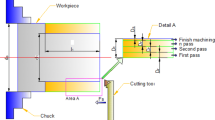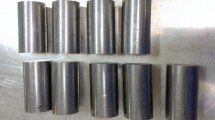Abstract
This paper presents a novel hybrid optimization approach based on teaching–learning based optimization (TLBO) algorithm and Taguchi’s method. The purpose of the present research is to develop a new optimization approach to solve optimization problems in the manufacturing area. This research is the first application of the TLBO to the optimization of turning operations in the literature The proposed hybrid approach is applied to two case studies for multi-pass turning operations to show its effectiveness in machining operations. The results obtained by the proposed approach for the case studies are compared with those of particle swarm optimization algorithm, hybrid genetic algorithm, scatter search algorithm, genetic algorithm and integration of simulated annealing, and Hooke–Jeeves patter search.
Similar content being viewed by others
References
Gilbert WW (1950) Economics of machining machining theory and practice. American Society Metals, Cleveland
Okushima K, Hitomi K (1964) A study of economic machining: an analysis of maximum profit cutting speed. Int J Prod Res 3:73–78
Ermer DS (1971) Optimization of the constrained machining economics problem by geometric programming. Transactions of the ASME Journal of Engineering for Industry 93:1067–1072
Boothroyd G, Rusek P (1976) Maximum rate of profit criteria in machining. Transactions of the ASME, Journal of Engineering for Industry 98:217–220
Shin YC, Joo YS (1992) Optimization of machining conditions with practical constraints. Int J Prod Res 30:2907–2919
Iwata K, Murotsu Y, Iwatsubo T, Oba F (1977) Optimization of cutting conditions for multi-pass operations considering probabilistic nature in machining conditions. Journal of Engineering for Industry-Transactions of ASME 99:211–217
Lambert BK, Walvekar A (1978) Optimization of multi pass machining operations. Int J Prod Res 16:259–265
Chen MC, Tsai DM (1996) A simulated annealing approach for optimization of multi-pass turning operations. Int J Prod Res 34:2803–2825
Ermer DS, Kromodihardo S (1981) Optimization of multi pass turning with constraints. Journal of Engineering for Industry-Transactions of the ASME 103:462–468
Gopalkrishan B, Khayyal FA (1991) Machining parameter selection for turning with constraints, pp. an analytical approach based on geometric programming. Int J Prod Res 29:1897–1908
Gupta R, Batra JL, Lal GK (1995) Determination of optimal subdivision of depth of cut in multi-pass turning with constraints. Int J Prod Res 33:2555–2565
Hati SK, Rao SS (1976) Determination of optimum machining conditions deterministic probabilistic approaches. Transactions of the ASME-Journal of Engineering for Industry 98:354–359
Tan FP, Creese RC (1995) A generalized multi-pass machining model for machining parameter selection in turning. Int J Prod Res 33:1467–1487
Yildiz AR (2012) A comparative study of population-based optimization algorithms for turning operations. Inf Sci 210:81–88
Holland HJ (1975) Adaptation in natural and artificial systems an introductory analysis with application to biology control and artificial intelligence. The University of Michigan Press, Ann Arbor, USA
Rao RV, Pawar PJ (2010) Parameter optimization of a multi-pass milling process using non-traditional optimization algorithms. Appl Soft Comput 10:445–456
Rao RV, Pawar PJ, Shankar R (2008) Multi-objective optimization of electro-chemical machining process parameters using a particle swarm optimization algorithm. Journal of Engineering Manufacture 122:949–958
Yildiz AR (2009) Hybrid immune-simulated annealing algorithm for optimal design and manufacturing. Int J Mater Prod Tech 34(3):217–226
Yildiz AR (2009) A new design optimization framework based on immune algorithm and Taguchi method. Comput Ind 60(8):613–620
Durgun I, Yildiz AR (2012) Structural design optimization of vehicle components using Cuckoo search algorithm. Mater Test 54(3):185–188
Kunakote T, Bureerat S (2011) Multi-objective topology optimization using evolutionary algorithms. Eng Optim 43(5):541–557
Yildiz AR (2012) Cuckoo search algorithm for the selection of optimal machining parameters in milling operations. Int J Adv Manuf Tech. doi:10.1007/s00170-012-4013-7 (in press)
Srisompom S, Bureerat S (2008) Geometrical design of plate-fin heat sinks using hybridization of MOEA and RSM. IEEE Transactions on components and packaging technologies 31:351–360
Yildiz AR (2012) A new hybrid differential evolution algorithm for the selection of optimal machining parameters in milling operations. Appl Soft Comput. doi:10.1016/j.asoc.2011.12.016 (in press)
Yildiz AR, Saitou K (2011) Topology synthesis of multi-component structural assemblies in continuum domains. Transactions of ASME, Journal of Mechanical Design 133(1):011008–011009
Yildiz AR (2012) Hybrid Taguchi-differential evolution algorithm for optimization of multi-pass turning operations. Appl Soft Comput J. doi:10.1016/j.asoc.2012.01.012
Gokdag H, Yildiz AR (2012) Structural damage detection using modal parameters and particle swarm optimization. Mater Test 6:416–420
Vijayakumar K, Prabhaharan G, Asokan P, Saravanan R (2003) Optimization of multi-pass turning operation using ant colony system. Int J Mach Tool Manuf 43:1633–1639
Chen MC, Chen KY (2003) Optimization of multipass turning operations with genetic algorithms: a note. Int J Prod Res 41:3385–3388
Chen MC (2004) Optimizing machining economics models of turning operations using the scatter search approach. Int J Prod Res 42:2611–2625
Yildiz AR (2009) A novel particle swarm optimization approach for product design and manufacturing. Int J Adv Manuf Technol 40(5–6):617–628
Yildiz AR, Solanki KN (2012) Multi-objective optimization of vehicle crashworthiness using a new particle swarm based approach. Int J Adv Manuf Tech 59(1–4):367–376
Yildiz AR (2009) A novel hybrid immune algorithm for global optimization in design and manufacturing. Robotics and Computer-Integrated Manufacturing 25(2):261–270
Coello CAC, Cortes NC (2004) Hybridizing a genetic algorithm with an artificial immune system for global optimization. Eng Optim 36:607–634
Yildiz AR, Ozturk F (2006) Hybrid enhanced genetic algorithm to select optimal machining parameters in turning operation. Proc Instn Mech Engrs, Part B, Journal of Engineering Manufacture 220(12):2041–2053
Yildiz AR (2013) A new hybrid artificial bee colony algorithm for robust optimal design and manufacturing. Appl Soft Comput. doi:10.1016/j.bbr.2011.03.031
Phadke SM (1989) Quality engineering using robust design. Prentice Hall, New York
Taguchi G, Chowdhury S, Taguchi S (2000) Robust engineering. McGraw-Hill, New York
Rao RV, Savsani VJ, Vakharia DP (2012) Teaching–learning-based optimization: an optimization method for continuous non-linear large scale problems. Inf Sci 183(1):1–15
Rao RV, Savsani VJ, Vakharia DP (2011) Teaching-learning-based optimization: a novel method for constrained mechanical design optimization problems. Computer-Aided Design 43(3):303–315
Togan V (2012) Design of planar steel frames using teaching–learning based optimization. Eng Struct 34:225–232
RV Rao, VD Kalyankar (2011) Parameters optimization of advanced machining processes using TLBO algorithm, EPPM, Singapore, 20–21 Sep 2011.
Author information
Authors and Affiliations
Corresponding author
Rights and permissions
About this article
Cite this article
Yildiz, A.R. Optimization of multi-pass turning operations using hybrid teaching learning-based approach. Int J Adv Manuf Technol 66, 1319–1326 (2013). https://doi.org/10.1007/s00170-012-4410-y
Received:
Accepted:
Published:
Issue Date:
DOI: https://doi.org/10.1007/s00170-012-4410-y




